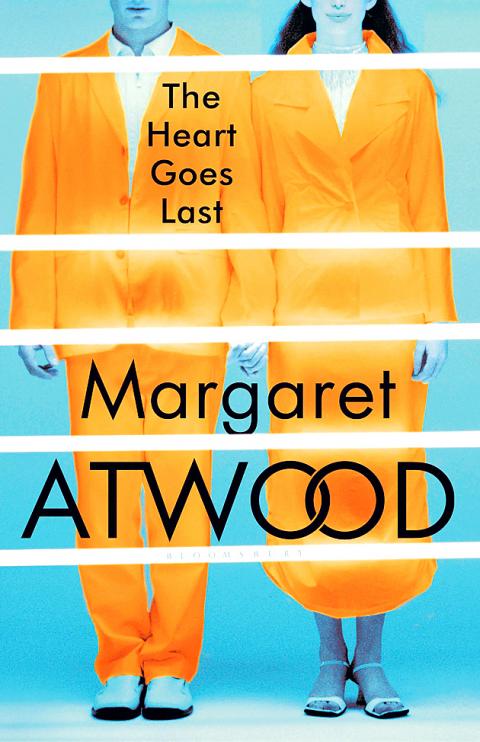Like a mad scientist from one of her futuristic novels, Margaret Atwood is an avid tinkerer who seems willing to experiment with almost any digital technology.
She has posted her writing on the free fiction site Wattpad, including some poetry and a zombie novel she cowrote. She has published fiction on Twitter, where she has more than 885,000 followers. She banters with fans on the online message board Reddit and has live-streamed footage of herself on the video platform Periscope. A video game app, Intestinal Parasites, was developed as a tie-in to her dystopian MaddAddam novels. She even invented a device called LongPen, which she envisioned as a way for people to sign their names remotely.
Her new book, The Heart Goes Last, grew out of her obsession with new forms of digital narrative. The project began three years ago as an online serial for the e-book publisher Byliner and morphed into a novel.

The story unfolds in a grim, futuristic America, where financial collapse has left much of the population unemployed, homeless and scavenging. A destitute married couple, Stan and Charmaine, are living in their car, dodging roaming bands of criminals and subsisting on dismal meals such as stale doughnuts. Their luck seems to turn when they are offered a chance to join a new planned community called Consilience, which promises free housing and jobs.
There’s a catch, of course. Consilience is basically a giant prison, where residents alternate between spending time as inmates and living in an oppressive, tightly controlled community, as free (but not really) citizens who tend to the prisoners. Eventually, Stan and Charmaine discover the shocking secret at the heart of the enterprise and separately plot their escape, a caper that involves Stan posing as an Elvis sex robot and being shipped in a box to Las Vegas.
Atwood, who is 75 and has a halo of gray curls and an acerbic sense of humor, said the idea came to her when she was reading about for-profit prisons.
“For-profit prisons are never a good idea, because to keep them profitable you have to keep having more prisoners,” she said in a recent telephone interview. To make her fictional penal system even creepier, she created greedy villains who victimize poor people by offering them jobs. “Think New Deal, only a much more sinister version,” she said.
Initially, Atwood planned to publish a single e-book with Byliner. But she got absorbed in the story and was intrigued by the process of shaping a narrative in full view of the public, building in cliffhangers and plot twists to keep readers coming back. She described it as a high-tech version of 19th-century serialized works such as Dickens’ The Pickwick Papers.
“She loves to experiment, and she’s not afraid if the experiment hits the skids,” said novelist Amy Grace Loyd, who was Atwood’s editor at Byliner. “She really wants to try things and be part of the current conversation.”
The concept was a hit. The first installment, I’m Starved for You, sold 40,000 copies after its release in spring 2012, according to Loyd. Three more episodes followed.
But Atwood and her longtime publisher, Nan Talese, agreed that she should hold back the rest of the story so she could publish it later as a new novel, and the online serial experiment ended in May 2013, leaving fans hanging.
To transform an episodic narrative into something more sweeping, Atwood rewrote the early chapters, adding the back story about how the characters arrived at Consilience. She worked out the novel’s madcap climax, which culminates with an outlandish plot twist involving Elvis impersonators in Las Vegas, a city that struck Atwood as a perfect dystopian setting.
“Nothing in it feels quite real,” she said.
Atwood has long been imagining disaster scenarios that threaten to annihilate humankind, from an epidemic of infertility in her 1985 novel, The Handmaid’s Tale, to a deadly virus that wipes out most of humanity in her 2003 dystopian novel, Oryx and Crake.
The Heart Goes Last wrestles with many of the same themes that have preoccupied Atwood for decades, such as sexism, the dangers of unbridled greed and the risky moral terrain that comes with technological progress
But critics are divided over whether her new novel deserves a place alongside Atwood’s earlier, celebrated dystopian works. Some reviewers dismissed The Heart Goes Last as a digital experiment gone awry.
“Maybe the fractured process of composition is to blame for the jarring unevenness of The Heart Goes Last,” the critic Ron Charles wrote in The Washington Post.
Atwood is clearly not risk averse when it comes to the projects she undertakes or the subjects she tackles. The Heart Goes Last is full of frank depictions of futuristic sex, including an unfortunate run-in with a malfunctioning robot and an amorous relationship between a woman and a teddy bear.
“She’s totally fearless, which is wonderful to watch,” said the novelist and book critic Lev Grossman. “Nothing is too arcane or technical or grotesque for her, and it all finds its way into her fiction.”
Her omnivorous nature is reflected in the diversity of her work. In a career spanning 56 years, she has published more than 40 books that crisscross the literary spectrum, from historical novels to science fiction, poetry, short stories, children’s books and nonfiction.
She’s won both the Booker Prize, for her 2000 novel, The Blind Assassin, and the Arthur C Clarke Award, one of science fiction’s most prestigious prizes, for The Handmaid’s Tale.
She is outspoken on some of the issues she tackles in her fiction, such as global warming and environmental disasters, financial inequality and animal rights. Someone once urged her to run for mayor of Toronto, but Gibson advised against it, saying “That would be a Norman Mailer-ish kind of thing to do,” she recalled.
For someone who has spent a chunk of her career plotting the collapse of civilization, Atwood is surprisingly bullish on the future of publishing — optimistic enough, at least, to write a book that will be sealed in a time capsule for a century.
This spring, she delivered a new manuscript titled “Scribbler Moon” to Future Library, a literary art project in Norway that will collect 100 texts over the next century, and publish them in 2114. Atwood was the first writer to submit a manuscript.
“It’s a very hopeful thing,” Atwood said. “It assumes that 100 years from now, there will still be readers, there will still be a library, there will still be books.”

April 28 to May 4 During the Japanese colonial era, a city’s “first” high school typically served Japanese students, while Taiwanese attended the “second” high school. Only in Taichung was this reversed. That’s because when Taichung First High School opened its doors on May 1, 1915 to serve Taiwanese students who were previously barred from secondary education, it was the only high school in town. Former principal Hideo Azukisawa threatened to quit when the government in 1922 attempted to transfer the “first” designation to a new local high school for Japanese students, leading to this unusual situation. Prior to the Taichung First

Chinese Nationalist Party (KMT) Chairman Eric Chu (朱立倫) hatched a bold plan to charge forward and seize the initiative when he held a protest in front of the Taipei City Prosecutors’ Office. Though risky, because illegal, its success would help tackle at least six problems facing both himself and the KMT. What he did not see coming was Taipei Mayor Chiang Wan-an (將萬安) tripping him up out of the gate. In spite of Chu being the most consequential and successful KMT chairman since the early 2010s — arguably saving the party from financial ruin and restoring its electoral viability —

The Ministry of Education last month proposed a nationwide ban on mobile devices in schools, aiming to curb concerns over student phone addiction. Under the revised regulation, which will take effect in August, teachers and schools will be required to collect mobile devices — including phones, laptops and wearables devices — for safekeeping during school hours, unless they are being used for educational purposes. For Chang Fong-ching (張鳳琴), the ban will have a positive impact. “It’s a good move,” says the professor in the department of

Toward the outside edge of Taichung City, in Wufeng District (霧峰去), sits a sprawling collection of single-story buildings with tiled roofs belonging to the Wufeng Lin (霧峰林家) family, who rose to prominence through success in military, commercial, and artistic endeavors in the 19th century. Most of these buildings have brick walls and tiled roofs in the traditional reddish-brown color, but in the middle is one incongruous property with bright white walls and a black tiled roof: Yipu Garden (頤圃). Purists may scoff at the Japanese-style exterior and its radical departure from the Fujianese architectural style of the surrounding buildings. However, the property